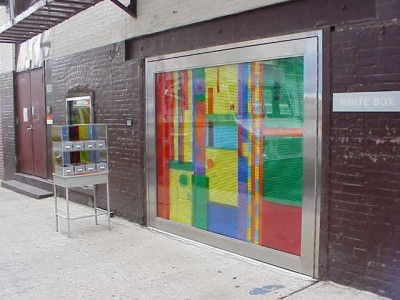Sublimations (2001)
Sublimations (2001)
project at Whitebox, New York, summer 2001
Essay by Anne Ellegood



Pablo Helguera’s Sublimations
…how often the figure of the “great” criminal,
however repellent his ends may have been,
has aroused the secret admiration of the public.
-Walter Benjamin
Gary Gilmore. James Earl Ray. Patricia Hearst. Jim Jones. Ted Bundy. Jonathan Berkowitz. All names captured in our collective consciousness for criminal activities deemed heinous and unforgivable. The stories of their crimes have eclipsed journalistic reportage to become legendary. Pablo Helguera’s Sublimations investigates the cultural role of the criminal in contemporary society, focusing on our propensity to ascribe near celebrity status to criminals and the likening of the psychological state of the criminal mind during acts of violence to that of the quasi-spiritual or creative realm.
Helguera’s window project provides visitors with a registry from which they can access short descriptions of crimes committed since the early 1900s. From notorious criminals to petty thieves, these accounts matter-of-factly describe crimes such as serial murder, ransom kidnappings, embezzlement, and political assassinations, among numerous others. Reading through the archive triggers the complex range of emotions Helguera’s project identifies as contributing to the ambiguous status criminals have attained in our society-shock, dismay, disgust, horror, curiosity, and even attraction. Using criminals’ names and swathes of primary colors, Helguera transforms the window into art-deco style stained glass, creating the aura of a house of worship.
Sublimations is the latest piece in Helguera’s on-going series entitled Everythingness, which explores states of heightened human experience. For a recent project at INTAR Gallery, everythingness (unfeeling), he examined the temporary state of euphoria that accompanies getting high on ecstasy. And, in an earlier work in the series, he created a fictional corporation that profits by positioning time as a commodity. Part of his longstanding interest in institutional critique, this work mimicked the marketing style of corporate identities so ubiquitous today-one that promotes the idea that we are all entitled to happiness and have the power to obtain this happiness, most commonly through materials possessions. Ultimately, Helguera proposes that our nearly desperate need to feel in control of our lives coupled with our desire for happiness and security makes us susceptible to everything from advertising campaigns for things we don’t need to experimentation with drugs that make us feel powerful and enlightened, at least temporarily. It is this temporary state that preoccupies Helguera-the fleeting, the ephemeral. In Sublimations, it is the moment of the criminal act that is under scrutiny and to which Helguera makes poignant comparisons. In criminals’ accounts of their deeds, they often describe feeling a sense of urgency or obsession followed by release, using a vocabulary usually associated with spiritual or supernatural experiences or profound moments of creative energy.
Sublimations suggests that it is perhaps our fascination with things that fall outside our capacity for logical comprehension that creates this unlikely link between crime and spirituality. Compelled by our desire to know the unknowable, our efforts to understand criminal behavior has resulted in massive public attention to the criminals themselves. The current climate surrounding crime in the domains of politics, journalism, and pop culture borders on an obsessive preoccupation with crimes and their perpetrators. The influx of reality television in recent years is just one example of the multiple variations on the theme of crime. Current television programming on all the major networks and several cable channels include live courtroom action where petty disputes are settled by a real judge, shows that follow cops while on their beat responding to calls about everything from domestic violence to bodega robberies, and reenactments of crimes and profiles of criminals that actually enlist the public in the law enforcements’ efforts to apprehend those at large. This phenomenon as well as the “get tough on crime” political rhetoric resulting in massive new legislation during the past few decades has created a contradictory environment in which our apparent disdain for criminals is outweighed by the inordinate amount of attention lavished on them in every media. Sublimations captures this tension between our feelings of repulsion and fascination with perpetrators. Through the juxtaposition of the beautiful pseudo-stained glass window with the numerous factual accounts contained in the registry, Helguera’s work creates a visceral response in the viewer that captures the very essence of this complex topic.
Anne Ellegood
(2001)